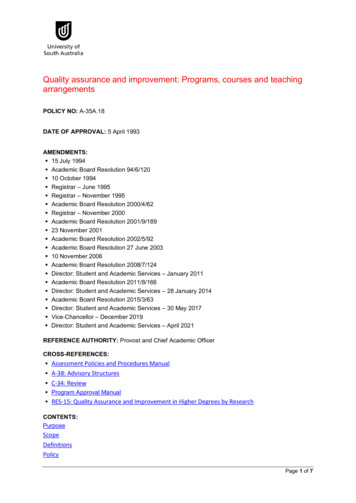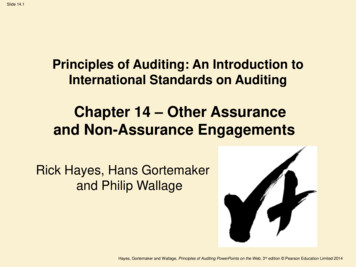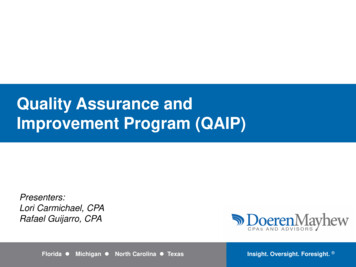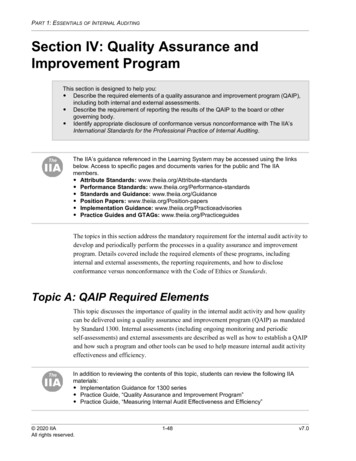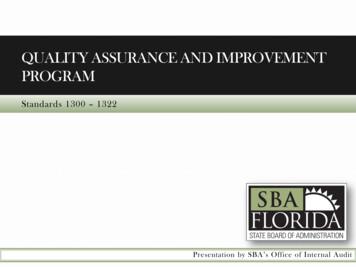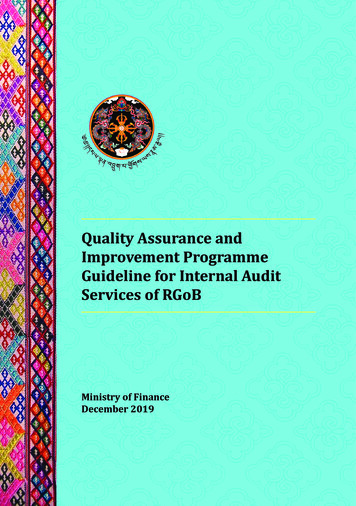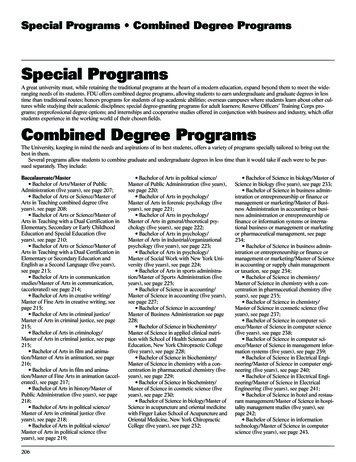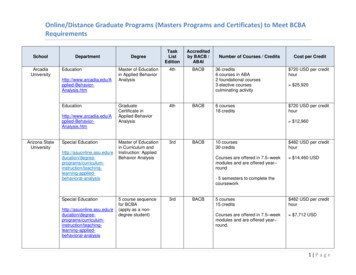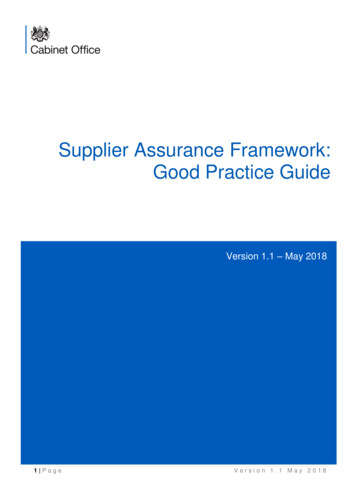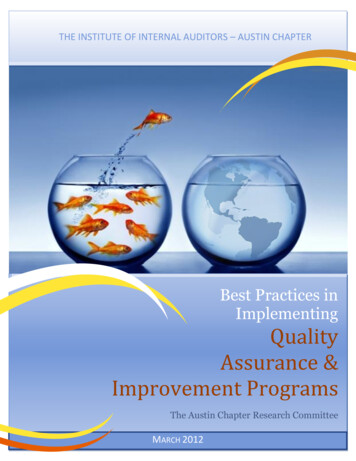
Transcription
THE INSTITUTE OF INTERNAL AUDITORS – AUSTIN CHAPTERBest Practices inImplementingQualityAssurance &Improvement ProgramsThe Austin Chapter Research CommitteeMARCH 2012
The Austin Chapter Research CommitteeKarin L. Hill, CIA, CGAP, CRMA, MBA, ChairDeQuincy L. Adamson, CGAPAnn Contella, CIA, CISA, CGAPCynthia G. Fish, CIA, CGAPMike Garner, CIA, CFE, MS-QSMSteve Goodson, CIA, CISA, CCSA, CGAP, CLEA, CRMADavid J. MacCabe, CIA, CGAP, CRMA, MPA
Table of ContentsExecutive Summary.1Introduction .2Literature Review .4Evolution of IIA Guidance on Quality .5Internal Auditor Articles and Other IIA Publications on Quality Assurance .6Other Articles on Quality Assurance .9Recent and Current Developments .9Research Methodology .11Respondent Demographics .12Number of Staff Assigned to the Internal Audit Department .12Industry .12Leadership Structure .13Survey Results .14Conducting Internal Quality Assessments .14Using the Results of Internal Quality Assessments .19Case Study.24Conclusions.28Acknowledgments.30Selected Bibliography .31Appendices:Appendix A – Quality Assurance and Improvement Program Framework .35Appendix B – Annual Self-Assessment Review .41Appendix C – Self-Assessment Report .53Appendix D – Internal Assessment and Business Plan .60Appendix E – Survey Tool.83i
This page intentionally left blank.ii
Executive SummaryQuality is never an accident; it is always the result of high intention, sincereeffort, intelligent direction and skillful execution; it represents the wise choice ofmany alternatives.WILLIAM A. FOSTER, quoted in Igniting the Spirit at Work: Daily ReflectionsA quality assurance and improvement program, as defined by The Institute of InternalAuditor’s (IIA) International Standards for the Practice of Internal Auditing, Standard1300 includes a combination of internal and external quality assessments. Internalassessments include a combination of ongoing monitoring of performance criteria andperiodic reviews against the standards and external quality assessments are to beconducted at least once every five years.This research paper identifies activities and practices of internal audit departmentsrelated to general compliance with Standard 1300 with more focused and specificinformation on internal assessments (Standard 1311). Internal assessments include theuse of a variety of evaluation tools to rate current internal audit performance in areas ofcompliance with audit standards, requirements, policies, and procedures; productionefficiency and quality; fulfillment of expectations of the organization’s board,management, and audit staff; and the value provided to the organization.The information and related support provided throughout each section of this researchpaper supports the conclusion that the most successful internal assessments providesignificant measurable, accountable, and feasible improvements to internal auditprocesses that can be reported and tracked for implementation, utilization, and results.The results identify common and best practices in conducting and resulting fromconducting internal quality assessments. Using the information and examples provided,internal audit departments can adapt a process that is effective for their organizationand meet the Standards.1
IntroductionThe practice of internal auditing is expected to add value to an organization. Value isdemonstrated to management, the board, and audit customers by conforming to theIIA’s International Standards for the Professional Practice of Internal Auditing(Standards) and implementing the profession’s best practices. Quality is a characteristicof adding value through meeting stakeholder needs and expectations, and is a keyrequirement of the Standards.The IIA’s Standard 1300, Quality Assurance and Improvement Program states, “The chiefaudit executive must develop and maintain a quality assurance and improvementprogram that covers all aspects of the internal audit activity.” Standard 1311, InternalAssessments, requires that internal assessments include:Ongoing monitoring of the performance; andPeriodic reviews performed by someone with sufficient knowledge of internalaudit practices.Chief Audit Executives (CAEs) can ensure that internal audit activities meet quality goalsthrough the implementation of a quality assurance and improvement program (QAIP).Three traits common to effective QAIPs are:the internal audit function has nurtured support from senior management andthe audit committee;a dedicated staff that performscontinuous monitoring and routinededicatedself-assessments of their auditstaffprocesses in preparation forleveragingmanagementexternal assessments required byauditsupportactivitiesthe Standards; andaudit tools used to leverage internalaudit activities to promoteconsistency and accessibility, and tosecure sensitive information.QAIPThe IIA interprets the Standard as follows: “A quality assurance and improvementprogram is designed to enable an evaluation of the internal audit activity’s conformancewith the Definition of Internal Auditing and the Standards and an evaluation of whetherinternal auditors apply the Code of Ethics. The program also assesses the efficiency andeffectiveness of the internal audit activity and identifies opportunities for improvement.”2
Although quality is a key requirement of the Standards for all audit activities, internalaudit functions are very diverse in their size, available resources, and the organization’scomplexity. To support these diverse audit shops, the IIA developed five levels ofquality, with the Path to Quality Model,1 designed to gauge the individual internal auditfunction’s quality capability target.Many internal audit departments target level three – conforming, which indicates thatthe function generally conforms to Standards, obtains an external assessment asrequired, and demonstrates continuous improvement in their activities. Levels one andtwo, beginning and emerging respectively, are usually associated with new auditfunctions that are building their quality assurance programs, audit departments thathave not had an external assessment performed, or the external assessment evaluatedthat the department did not conform to the Standards. In contrast, levels four and five,leveraging and leading, represent a well-seasoned internal audit function that has rated“fully conforms” through an external assessment and has implemented higher levels ofquality controls to add additional value to their organizations.While QAIPs are included at every level of the Path to Quality Model, the complexity ofthe program evolves as internal audit functions mature to beyond conformance. At thevery least, a QAIP should include the following internal control processes:Involvement with the organization and a clear understanding of responsibilities;Annual risk assessment and ongoing monitoring of organizational activities; and,Departmental performance controls and milestones to ensure quality of internalaudits performed.Investing resources and time for ongoing monitoring to optimize internal audit activitiesprovides a benefit through enhanced risk assessment processes, an improved controlenvironment, strengthened relationships with management and regulators, andultimately greater efficiency. The IIA interprets ongoing monitoring as “an integral partof the day-to-day supervision, review, and measurement of the internal audit activity.Ongoing monitoring is incorporated into the routine policies and practices used tomanage the internal audit activity and uses processes, tools, and information considerednecessary to evaluate conformance with the Definition of Internal Auditing, the Code ofEthics, and the Standards.”1IIA Path to Quality Model, l-quality-assessmentprocess/path-to-quality/3
Internal Audit functions with a QAIP at levels four and five implement a combination ofbest practices; some of which include:The CAE is actively involved in the organization to strengthen governance, riskmanagement, and internal control processes.The CAE has earned the confidence of clients, the organization’s stakeholders,and regulators.The CAE has earned the respect of the internal audit staff through opendiscussions for continuous improvement of the audit function, commitment tocontinuing education and training of the internal audit staff, and encouraginginvolvement in leadership activities.The internal audit staff collectively possesses skills and certifications relevant tothe audit environment, including IT auditing expertise.A comprehensive charter clearly identifies the roles and responsibilities of theinternal audit staff and annual risk assessment processes are linked to theorganization’s universe with a framework that involves continuous monitoringfor focused audit planning and efficiency.Controls are in place to ensure that internal audit reports are clear and concise,timely, and focused on risk with procedures to follow up on management actionplans.Technology based audit tools are used to monitor performance milestones setby internal audit to ensure a highly productive staff, and to provide forconsistency, accessibility, and security of audit working papers.A dedicated staff monitors the performance outcome measures to addressinefficiencies or control weaknesses and the results are reported to thegoverning body at least annually.Literature ReviewProviding an assurance of quality for products and services has been a long-heldcommitment for internal audit professionals. The Institute of Internal Auditors (IIA)recognized the importance of quality assurance in the initial Standards for theProfessional Practice of Internal Auditing adopted in 1978.2The former Standard 560 provided “The director of internal auditing should establishand maintain a quality assurance program to evaluate the operations of the internal2IIA, Standards for the Professional Practice of Internal Auditing, 1978.4
auditing department.”3 This standard included three elements: supervision, internalreviews, and external reviews. These three elements remain important ingredients foran effective Quality Assurance and Improvement Program (QAIP) some 34 years later.Evolution of IIA Guidance on QualityThe IIA has updated advice to practitioners over the years via Standards additions andrevisions, practice advisories, publications, examples, tools, and techniques.The initial Standards required external Quality Assurance Reviews (QARs) every threeyears corresponding with the guidance promulgated by the United States GovernmentAccountability Office (formerly the United States General Accounting Office) over manyyears.4 The IIA determined that a five-year external review schedule was moreappropriate and has been the requirement since 2002.Major revisions to the Standards have occurred periodically over the years, mostsignificantly in 1999, 2002, 2006, 2009, and 2011.A special committee known as the Guidance Task Force reviewed IIA standards andguidance and in 1999 concluded that a more robust definition of internal auditing waswarranted. The new Professional Practices Framework was adopted and emphasizedfive major purposes including the need to “require a quality assurance mechanism toensure compliance with the Standards.”5Standards revisions in 2002 and 2006 gave greater credence to the need to more fullyimplement the requirements of Standard 1300 pertaining to internal and externalassessments of internal audit functions. The mandatory nature of these revisions wasillustrated by the change of the word “should” to “must” over 140 times throughout theStandards.Over the years additional supporting standards in the 1300 series were implemented toreflect the following configuration:Standard 1300 – Quality Assurance and Improvement ProgramStandard 1310 – Requirements of the Quality Assurance and ImprovementProgramStandard 1311 – Internal Assessments3Ibid.United States Government Accountability Office, Government Auditing Standards, most recently rev
Standard 1320 – Reporting on the Quality Assurance and Improvement Program Standard 1321 – Use of “onforms with the . International Standards for the Professional Practice of Internal Auditing ” Standard 1322 – Disclosure of Nonconformance. Anderson (1983) 6. published one of the earliest guides to conducting a quality review program and suggested there are four stages in the process .
